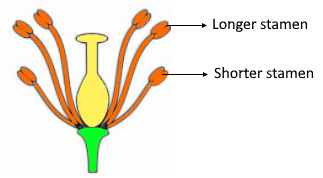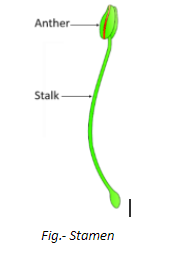
Tetradynamous stamens are found in
(a)Brassica
(b)Pisum
(c)Hibiscus
(d)Cucurbita
Answer
572.1k+ views
Hint: Such an arrangement of stamen is shown by the plants that have 6 stamens in the androecium that are arranged in two whorls. Relatively short stamens are found in the outer whorl while the inner one has long stamens.
Complete answer:
In the Tetradynamous condition, the flower has six stamens in the androecium out of which two are shorter and the other four are longer. The shorter stamens are arranged in the outer whorl while the four longer stamens in the inner whorl. This type of arrangement of stamen is found in plants belonging to Brassicaceae or Cruciferae or Mustard family and is the characteristics of this family. A representative diagram of Tetradynamous condition has been shown below –

Additional Information: Stamen is the male reproductive part of a flowering plant that comprises an anther connected to a filament and produces pollens. Microsporangia, which develops into the pollen grains, are located within the anther. All the stamens present in a flower collectively form androecium and their number varies from species to species. Besides the number, stamens also vary in appearance and position in different plant species, and in some plants, they are fused at either the anther or the filament.

So, the correct answer is ‘Brassica’.
Note:
Based on the length, stamens are arranged in three different types in the flowers –
Didymous – here, four stamens are present in the two equal pairs.
Didynamous – number of stamens and arrangement is similar to the didymous condition but here, in one pair, the two stamens are longer while in the other pair, they are shorter.
Tetradynamous – six stamens are present in the flower in two sets where the two stamens in the outer set are shorter than the four stamens in the inner set.
Complete answer:
In the Tetradynamous condition, the flower has six stamens in the androecium out of which two are shorter and the other four are longer. The shorter stamens are arranged in the outer whorl while the four longer stamens in the inner whorl. This type of arrangement of stamen is found in plants belonging to Brassicaceae or Cruciferae or Mustard family and is the characteristics of this family. A representative diagram of Tetradynamous condition has been shown below –

Additional Information: Stamen is the male reproductive part of a flowering plant that comprises an anther connected to a filament and produces pollens. Microsporangia, which develops into the pollen grains, are located within the anther. All the stamens present in a flower collectively form androecium and their number varies from species to species. Besides the number, stamens also vary in appearance and position in different plant species, and in some plants, they are fused at either the anther or the filament.

So, the correct answer is ‘Brassica’.
Note:
Based on the length, stamens are arranged in three different types in the flowers –
Didymous – here, four stamens are present in the two equal pairs.
Didynamous – number of stamens and arrangement is similar to the didymous condition but here, in one pair, the two stamens are longer while in the other pair, they are shorter.
Tetradynamous – six stamens are present in the flower in two sets where the two stamens in the outer set are shorter than the four stamens in the inner set.
Recently Updated Pages
Master Class 12 Business Studies: Engaging Questions & Answers for Success

Master Class 12 Economics: Engaging Questions & Answers for Success

Master Class 12 English: Engaging Questions & Answers for Success

Master Class 12 Maths: Engaging Questions & Answers for Success

Master Class 12 Social Science: Engaging Questions & Answers for Success

Master Class 12 Chemistry: Engaging Questions & Answers for Success

Trending doubts
What is meant by exothermic and endothermic reactions class 11 chemistry CBSE

Which animal has three hearts class 11 biology CBSE

10 examples of friction in our daily life

One Metric ton is equal to kg A 10000 B 1000 C 100 class 11 physics CBSE

1 Quintal is equal to a 110 kg b 10 kg c 100kg d 1000 class 11 physics CBSE

Difference Between Prokaryotic Cells and Eukaryotic Cells




